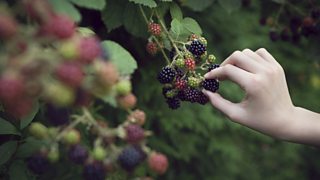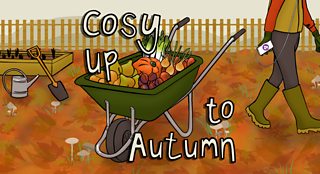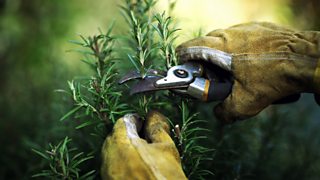What's so brilliant about Autumn...
By writer and presenter Joanna Pinnock
When does Autumn actually start? You could say it’s the 1st of September, the official meteorological first day of the season or maybe the Autumn equinox which falls on 21st September or thereabouts.
Personally, I like to take my cue from nature as I watch and listen out each year for the little signs and key moments which tell me that the seasons are changing and the year is turning.
It begins as the swallows gather in increasing numbers on the telephone lines by a local farm – same place every year – chittering and chattering away to each other, as if discussing their imminent departure south.

-
![]()
Cosy up to Autumn
A collection of programmes and features embracing the nature of Autumn
After the quiet days of late summer, a robin bursts into song at dawn (its autumn song different to its springtime one, by the way) and young male tawny owls hoot softly to each other across the gardens at night. Jays screech through the woodland, flashing white rumps and blue wing feathers as they carry acorns to secret hiding places and speckled garden spiders weave their beautiful, intricate webs across my window frames and wheelie bins.
The days are growing shorter, the mornings just that little bit chillier and the exciting, busy season of territory-marking and migration, fuelling up and hunkering down is beginning.

Over the past few decades, I’ve been lucky enough to present many a wildlife programme for the Βι¶ΉΤΌΕΔ’s Natural History Unit, including a number of Living Worlds.

Spending a whole day with enthusiastic experts on hand, scrutinising the life-cycle, ecology and behaviour of just one species – plant or animal – takes some beating. What better way to learn how to tell a native 7-spot from an invasive harlequin than to spend a morning, mug of tea in hand, watching both species of ladybird jostling for space in the corner of a window frame, as they compete for a cosy nook to spend the winter?
But you don’t need to be recording a radio programme to enjoy the sights and sounds of the season. Just go for a stroll, take a moment or two to watch and listen and you’ll soon find yourself drawn into the mini dramas playing out in the natural world at this colourful and fascinating time of year.
Wander up to some ivy in flower and you’ll witness a feeding frenzy. In early autumn, ivy is, quite literally, buzzing with life. Its nectar–rich, pungent, clusters of flowers are simply irresistible to all sorts of insects. See if you can spot some Ivy Bees amongst the hoverflies, honeybees, wasps and bumblebees. Relatively new to the UK, they’re quite easy to pick out with their almost wasp–like black and bright yellow striped abdomens.

If you enjoy a bit of blackberry-picking (never after Michaelmas, mind, when the devil spits on the berries, or so my granny used to tell us) you might well be joined by a red admiral butterfly getting tipsy on the sweet juices of over-ripe fruit. Harvestmen, with their tiny round bodies and impossibly long, gangly legs, lurk amongst the leaves ready to pounce on their insect prey. And take a closer look at that old bird’s nest tucked away amongst the bramble’s protective prickly stems: if there’s a little pile of hawthorn berries and hazelnuts inside, it’s likely that a wood mouse has been stocking up for winter.

As a radio person, though, for me it’s the sounds of autumn which really capture my imagination. It’s relatively rare to hear the throaty “cronk” of a raven here in the flatlands of Cambridgeshire, although these majestic, clever birds are now much more widespread than they once were. But I love the quintessentially autumnal soundtrack of big flocks of rooks, cawing to each other as they fly from the stubble fields back to the safety of their roost at sunset. And bickering pairs of site-faithful, bond-faithful jackdaws, jealously guarding their chimney-pot nest sites from interlopers and already preparing for next spring.
As the swallows leave, I listen out each evening for a soft, barely audible “tseep” up in the sky which tells me that the first redwings are arriving from Scandinavia under cover of darkness – winter thrushes soon to be joined by their bigger cousins, the fieldfares. And I will definitely make a date to head up to the North Norfolk coast for that most breathtaking of wildlife spectacles: thousands of honking, gaggling pink–footed geese, newly arrived from Iceland, flying over the sea at sunrise and passing directly overhead wave after wave, skein after skein, as they head inland to find breakfast on the sugar beet fields.
Autumn can be awesome and it’s definitely my favourite time of year. So wrap up, get out there and enjoy!
Find the full listing of all Radio 4 Extra's Autumn programmes here.

More mellow fruitfulness on Radio 4 Extra...
-
![]()
Cosy up to Autumn
A collection of programmes and features embracing the nature of Autumn.
-
![]()
Living World
Intimate encounters and extraordinary observations of wild nature in Britain and beyond.
-
![]()
Tweet of the Day
Discover birds through their songs and calls. Hear each call or song, followed by a story of fascinating ornithology inspired by the sound.
-
![]()
Elegies from a Suburban Garden
Botanist Phil Gates reflects on the emotional rollercoaster every gardener experiences as the seasons change.



